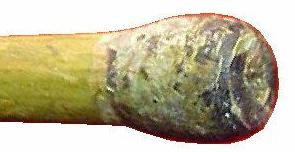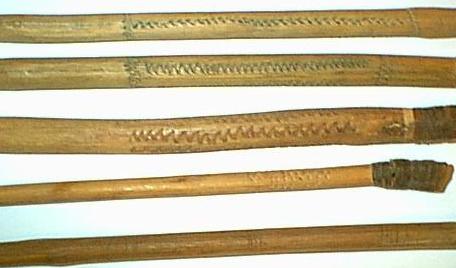Australian Children's Darts
Recently I purchased a lot from a dealer in Australia that included several children's darts. I have no idea of whether the techniques used on these would carry over to adult-sized darts and spears, but they just make too much sense NOT to carry over to some degree.
The darts ranged in length from about 18" to almost 40", but they all showed the same construction techniques.
The Shaft
The shafts of the darts were constructed of a light wood, similar in feel and weight to willow. The diameters ranged from about 3/8" to 1/2", and the lengths of the individual sections ranged from 18 to 24" long. At that point, the ends were bevelled for about 3/4" up the shaft and they were then glued together and wrapped.


While this does give the wood a weak point at the joint, it makes sense for a few different reasons. Given the thin diameter of the darts, they'd be very prone to breaking if they were made from longer continuous pieces of wood. This also keeps them from warping, since a short piece of wood won't warp as readily as a longer piece. It is also extremely difficult to even FIND a branch or shoot of that thin diameter for more than 24", so this way they can keep the overall diameter of the shaft thinner. (For adult-sized darts, they probably used thicker pieces (possibly up to 3/4" or larger), but in this manner they could make it a consistent diameter all the way through.) And finally, when (not if) the dart DID break, it would be very easy to repair. Simply remove the broken piece, splice in a new one, and you're ready to go again.
The Point

The tips of the darts were carved from a piece of wood into a willow-leaf shape. They ranged in size from 4" to 5" long, from 1/2" to 3/4" wide, and from about 1/4" to 3/8" thick. The front end was sharpened into a point; the sides were carved thin to form blades along the edges; and the bottom was bevelled the same way the shaft pieces were. It was then glued and wrapped in place.
Again, this makes sense. Wooden points are a small investment in time for a very effective weapon. They can be shaped very easily with materials at hand, so they don't require specialized tools. And while they are prone to falling off the shaft, they will remain in the animal, causing them to bleed out. Just carve a new point, glue and wrap it, and you're set. Also, by using wood you can keep the points thinner, so they are closer to the diameter of the shaft itself. This will help penetration -- usually there's a "binding point" where the point meets the shaft, and it's hard to get the dart past that point. By keeping it close to the same diameter, the shaft should follow the point into the animal very effectively, giving you deeper penetration and a better chance of killing the animal.
The Nock

The darts I received did not have nocks on them, which surprised me. Perhaps these were more for display or throwing by hand than they were for throwing with a woomera, but perhaps they were just modified somewhere along the line. I'm not sure. But I have run across pictures of the nock end of Australian darts, so I'll use that information here.
It appears that the nocks were built up with pitch or resin, and then a "dimple" was made in the bottom of that. This makes sense -- Australian woomeras tend to have VERY sharp pegs on them, which would cut into wood deeply after a while. If you made the nocks out of resin, though, they would resist any wear from the peg. That may be why none of my darts had a nock -- perhaps it simply fell off somewehere.
The Decoration

Of the 11 darts I received, there was decorative carving on all but two of them. The decoration was simply small carvings by the point end, running 3 to 5" long. There seemed to be three different variations of the "wave" carving design, which makes me think these were made for siblings, and the difference in designs were to show whose dart was whose.
All in all, these darts were brilliant in their simplicity and effectiveness. Next summer, I plan on making some of these designs myself for target practice, and I'll let you know how they work out.
Dart Construction |
Home
Written December 29, 2003





